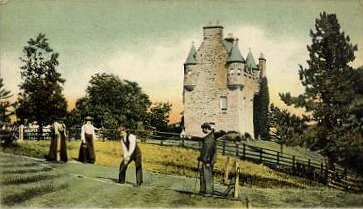|
The Rev. William Ahercrombie, writing in 1686, says: "Many of the pretty dwellings of the gentry here are sweet desyrable places; but for the good building, gardens, orchards, and all other accommodations, Kilhenzie is the chiefe, lying about a short myle south from the towne of Mayboll." In 1429, Kilhenzie belonged to Thomas Kennedy of Kirkoswald; afterwards it passed into the hands of the laird of Bargany; subsequently it became the residence of the Carrick branch of the Bairds; and finally, it became the property of the Fergussons of Kilkerran. In the old history of the Kennedys, an account is given of one of those rough-handed deeds which were common in those days. It appears that John Baird, of Kilhenzie, had married for his second wife a sister of the laird of Bargany. In his absence, his son took possession of some victual left by his father with his step-mother. She complained to her brother, the laird, who came with an armed force, "brak the yett" of Kilhcnzie, and carried off a quantity of grain equal in value to that taken by the son. Baird, on his side, complained to the Earl of Cassillis, who threatened to carry fire and sword into the halls of Bargany. But, apparently, he thought better of it, and so "jouked and let the jaw gae by." The old historian remarks that the Earl had recently brought home some gunpowder from Italy, which he could have used with effect; and this indicates that about the end of the sixteenth century, powder was rather a scarce commodity in Scotland. There are few relics to be seen now about Kilhenzie, except one or two carved stones which evidently adorned the edifice in the days of its former grandeur. |
|
|
 Kilhenzie
Castle stands about a mile from the town, and is one of the most complete
specimens of a Baronial Keep we have. Some forty years ago, it was in ruins, but
the owner, Sir James Fergusson, made the old castle habitable, and now it is a
most desirable residence. It stands on a green knoll, at some little distance
off the road, and still retains a few of its ancient trees, although the large
Ash which used to adorn it, and into whose hollow heart half-a-dozen
people could stow themselves, has, at last, succumbed to Time.
Kilhenzie
Castle stands about a mile from the town, and is one of the most complete
specimens of a Baronial Keep we have. Some forty years ago, it was in ruins, but
the owner, Sir James Fergusson, made the old castle habitable, and now it is a
most desirable residence. It stands on a green knoll, at some little distance
off the road, and still retains a few of its ancient trees, although the large
Ash which used to adorn it, and into whose hollow heart half-a-dozen
people could stow themselves, has, at last, succumbed to Time.